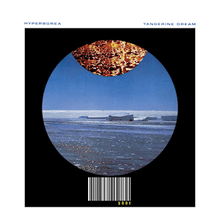Hyperborea (album)
| Hyperborea | ||||
|---|---|---|---|---|
 | ||||
| Studio album by Tangerine Dream | ||||
| Released | November 1983 | |||
| Recorded | August 1983 | |||
| Genre | Electronic music | |||
| Length | 40:15 | |||
| Label | Virgin | |||
| Tangerine Dream chronology | ||||
| ||||
| Professional ratings | |
|---|---|
| Review scores | |
| Source | Rating |
| AllMusic | |
Hyperborea is the nineteenth album by Tangerine Dream.[2] It spent two weeks on the UK album chart peaking at No.45.
"No Man's Land" makes heavy use of sitar. "Cinnamon Road" also utilizes sitar, but with a conventional pop music structure. The longest track, "Sphinx Lightning"', recapitulates every style explored by Tangerine Dream over the previous decade.
The album title refers to Hyperborea, a mythical, idyllic land in the Ancient Greek tradition, supposedly located far to the north of Thrace and where it was claimed the sun shone twenty-four hours a day.
Track listing
| No. | Title | Length |
|---|---|---|
| 1. | "No Man's Land" | 9:03 |
| 2. | "Hyperborea" | 8:31 |
| 3. | "Cinnamon Road" | 3:54 |
| 4. | "Sphinx Lightning" | 19:56 |
Personnel
References
- ↑ Swan, Glenn. Hyperborea at AllMusic
- ↑ Berling, Michael (29 September 2016). "Hyperborea". Voices in the Net.
This article is issued from Wikipedia - version of the 11/19/2016. The text is available under the Creative Commons Attribution/Share Alike but additional terms may apply for the media files.